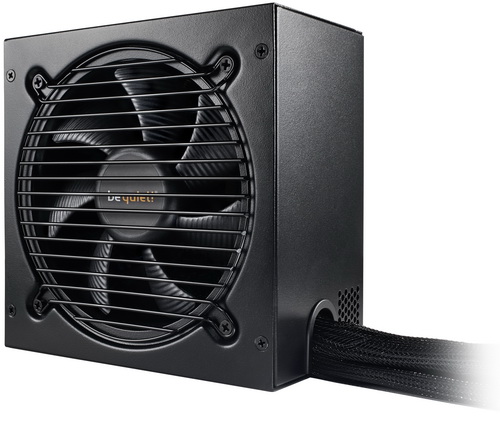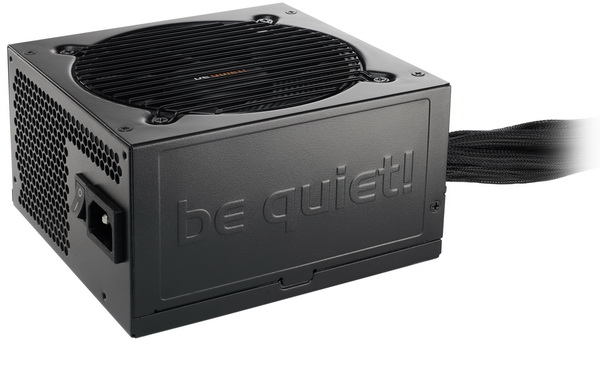INTRODUCTION

As demand for high-quality yet affordable power supply units is still (and probably will never cease to be) on the rise it's only normal to see more and more manufacturers get behind to promote such models rather than their higher-end and far more expensive brothers. Some compromises of course are to be expected in order to keep production costs to a minimum (such as semi-modular or fully hardwired models with not very long features lists) but from what we've seen recently some of these PSUs manage to hold their own when compared to much more expensive models. Be quiet! likes to update their product lines at least once per year and so the announcement of their brand new Pure Power 11 line of PSU's a couple of months ago didn't come as a surprise to us. So today we'll start covering that line by testing the Pure Power 11 700W model (L11-700W) first.
be quiet! is a premium brand of power supplies, PC cases and cooling solutions for desktop PCs. Consistently the leader in the German PC power supply market since 2007*, be quiet! is one of the most successful PSU brands in Europe. This enduring success is largely thanks to the typical German passion for quality and precision. All product conception, design and quality control is performed in Germany. German expertise is evident the moment an idea is born and throughout the entire design and production process. be quiet! never releases a product until it meets the highest expectations. All materials used – from the smallest screws to the metals in the cases – are tested to rigorous standards. That is why be quiet! power supplies, PC cases, CPU coolers and case fans are among the most silent, powerful and reliable on the market. Innovative engineering concepts coupled with an uncompromising choice of premium materials and world-class manufacturing quality make be quiet! second to none when it comes to noise reduction. With over ten years of experience, be quiet! are truly the quietness experts.
The Pure Power 11 line of PSUs by be quiet! includes two sub-lines the L11 which includes 6 wattage models (300/350/400/500/600/700W) and the L11-CM which currently consists by 4 wattage models (400/500/600/700W). The main difference between these two sub-lines is their design so whereas the L11 models feature all their power cables hardwired into the main chassis the L11-CM sub-line is semi-modular so you can save some space by not using every single power cable in the bundle. The Pure Power 11 700W L11 model which we're testing today (840W max) features an 80 Plus Gold certification (electrical efficiency up to 92%), two 12V rails (56A with a maximum supported power of up to 672W), support for multiple graphics cards (four 6+2 pin PCIe connectors), active PFC, DC to DC power conversion and a plethora of available electrical protections including OCP (over charge protection), OVP (over voltage protection), UVP (under voltage protection), SCP (short circuit protection), OPP (over power protection) and OTP (over temperature protection). Be quiet! also covers the entire Pure Power 11 line with a 5 year limited warranty.
SPECIFICATIONS AND FEATURES

PACKAGING AND CONTENTS
Just like every other PSU by be quiet! the Pure Power L11-700W arrived inside a black box that has a large product picture at the front right beneath the company and 80 Plus Gold certification logos and just above its main features.

 The features list is also printed on both sides of the box in 5 different languages.
The features list is also printed on both sides of the box in 5 different languages.
At the rear of the box we see the electrical specifications of the unit, its measurements and the available power connectors.
Be quiet! has placed the unit inside a bubble wrap protective.
Along with the Pure Power 11 700W and its power cord you will also get 5 cable ties, user manual and 4 mounting screws.
THE PURE POWER 11 700W L11-700W EXTERIOR
As mentioned in the intro page the Pure Power 11 700W model has all its power cables hardwired into the chassis.
Be quiet! used one of their SilentWings 120mm fans to cool the interior of this unit.

 The company logo is located on the left side of the enclosure while on the right there's a large sticker with the unit's electrical specifications.
The company logo is located on the left side of the enclosure while on the right there's a large sticker with the unit's electrical specifications.
All of the power cables are sleeved and hardwired into the chassis.
At the rear we find the typical honeycomb perforation, the on/off power button and the power port.
THE PURE POWER 11 700W L11-700W INTERIOR
The SilentWings model used in the Pure Power 11 700W model is a rifle-bearing fan that can reach up to 2000RPM (strangely enough on the be quiet! page maximum speed is reported at 1440RPM).
Interior design is clean and looks like this was manufactured by FSP.
Primary capacitor is manufactured by the Taiwanese TEAPO and is certified for use up to 85 degrees Celsius.


Secondary capacitors are also manufactured by TEAPO but are certified for use up to 105 degrees Celsius.
TEST BED


TESTING METHODOLOGY
Using a dedicated measurement instrument such as a Chroma or a SunMoon to test power supply units is without doubt the most ideal and accurate way (not to mention the fastest) to do that currently. However it's certainly not the only way there is and so pretty much anyone can test a power supply unit just by using a computer. Certainly limitations do apply and so you can't really test a 1000W power supply if your system only uses 500W at peak loads and that's why during the past 5 years i have saved certain hardware components for the purpose of building a dedicated PSU test rig. True it may not be as accurate as the above mentioned solutions but it comes really close and is in fact closer to real world usage. So as always we ran several games with maximum graphic options enabled at a resolution of 2560x1600 in order to stress every hardware component and increase the overall power demands of the system. The Passmark BurnIn Test was also used to overstress the components in an effort to provide the most accurate results possible. As a final test we also used the latest OCCT 4.4 software and its dedicated PSU testing suite since it can really bring a power supply to its knees after inside a few minutes.
Rail stability was checked/measured with the CPUID Hardware monitor and a Metex multimeter which also recorded the system load in idle and in load. As always try to remember that the power consumption numbers listed in the graph are the highest (Peak) ones recorded during the entire duration of the tests and not the average ones. Noise levels coming from the fan were recorded using the high precision HD600 ExTech Sound dBA Meter from the rear of the unit and at a range of no more than 5-10cm. Readings under load are recorded the exact moment we manually switch the fans of all graphics cards from full speed to almost zero, that way the fan of the power supply does not have enough time to slow its RPM and so by doing this we get very accurate noise level readings. Needless to say in order to get 100% accurate readings you need to have a noise isolated room for that exact purpose, something which is quite impossible unless you are working inside a real lab (some people use very small noise insulated boxes but due to their size both heat and noise exceed normal levels and so the results can't really be considered to be 100% accurate). Also do take into account that since all noise measurements take place from just 5-10cm away the final noise levels to reach your ears will be considerably less.
TEST RESULTS



CONCLUSION

Even though getting a new PSU with an output of 700W means that you’ll be having quite a few power cables to use (for example the Pure Power 11 700W Essential has 7) and thus a fully modular or even semi-modular model would be best for people who care about looks and maximum possible case airflow (however nothing a tower with a PSU shroud/cover can’t fix) this is a good example of how we just can’t have it all. With that out of the way we can’t say that we’ve had any issues with the L11-700W since build quality is exactly what you’d expect by a be quiet! product (alas one of their low/mid-end models), the 80 Plus Gold efficiency certification is very good for a product of its category, it offers good rail stability and last but not least noise levels never crossed the 40dBA barrier during our tests (yet do keep in mind that we didn’t max-out the power output of the L11-700W so at full load the fan could produce even higher dBA numbers).
Typically price is what makes or breaks low/mid-end products and with a current price tag set at around USD140 inside the USA (unfortunately the L11-700W is still not available in Newegg) things are not looking good. On the other hand the Pure Power 11 700W (L11-700W) currently retails for 93.90Euros inside the EU (Amazon DE) and although it’s still just a tad higher than we had hoped for a non-modular model still we don’t think it’s overboard. With that out of the way the L11-700W is clearly aimed towards casual consumers who are willing to spend slightly more than what they would on a PSU from a noname brand in order to get build quality, good rail stability, 80 Plus Gold electrical efficiency and a 5 year warranty and that’s why it comes highly recommended by us.
PROS
- Build Quality
- Good Rail Stability
- 80 Plus Gold Certified
- Peak Output (840W)
- Electrical Protections (OCP/OVP/UVP/SCP/OPP/OTP)
- 5 Year Warranty
CONS
- Not Modular
- Price (For Some)
- Current Availability (USA)

 O-Sense
O-Sense


















.png)

